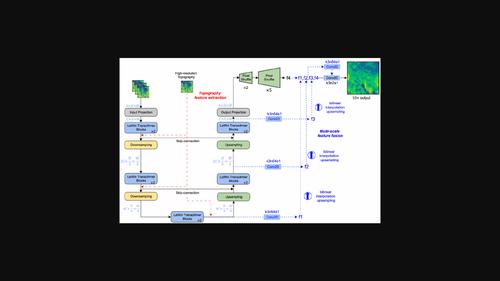Investigating transformer‐based models for spatial downscaling and correcting biases of near‐surface temperature and wind speed forecast
IF 3
3区 地球科学
Q2 METEOROLOGY & ATMOSPHERIC SCIENCES
引用次数: 1
Abstract
Abstract High‐resolution and accurate prediction of near‐surface weather parameters based on numerical weather prediction (NWP) models is essential for many downstream and real‐world applications. Traditional dynamical or statistical downscaling methods are insufficient to derive high‐resolution data from operational NWP forecasts, making it essential to devise new approaches. In recent years, an increasing number of researchers have explored the implementations of deep learning (DL) based models for spatial downscaling, motivated by the similarity between the super‐resolution (SR) problem in computer vision (CV) and downscaling. Furthermore, while transformer‐based models have become state‐of‐the‐art models for many SR tasks, they are rarely applied for downscaling of weather forecasts or climate projections. This study adapted transformer‐based models such as SwinIR and Uformer to downscale the temperature at 2 m () and wind speed at 10 m () over Eastern Inner Mongolia, encompassing the area from 39.6–46°N latitude and 111.6–118°E longitude. We used high‐resolution forecast (HRES) data from the European Centre for Medium‐range Weather Forecast (ECMWF) with a spatial resolution of 0.1° as the input and gridded observation data from the China Meteorological Administration (CMA) Land Data Assimilation System (CLDAS) at a spatial resolution of 0.01° as the target. Given that the models use observation data rather than a coarse‐grained version of forecast data as the target, they accomplish both bias correction and spatial downscaling. The results demonstrate that the performance of SwinIR and Uformer is superior to that of two convolutional neural network (CNN) based models (UNet and RCAN). Additionally, we introduced a novel module to extract features of varying resolution from the high‐resolution topography data and applied a multiscale feature fusion module to merge features of different scales, contributing to further enhancement of Uformer's performance.

研究基于变压器的空间降尺度模型,并校正近地表温度和风速预报的偏差
基于数值天气预报(NWP)模式的高分辨率和准确的近地表天气参数预测对于许多下游和现实世界的应用至关重要。传统的动态或统计降尺度方法不足以从实际的NWP预报中获得高分辨率数据,因此必须设计新的方法。近年来,越来越多的研究人员探索了基于深度学习(DL)的空间降尺度模型的实现,其动机是计算机视觉(CV)中的超分辨率(SR)问题与降尺度之间的相似性。此外,虽然基于变压器的模型已成为许多SR任务的最先进模型,但它们很少用于缩小天气预报或气候预测的比例。本研究采用了基于变压器的模型,如SwinIR和Uformer,缩小了内蒙古东部地区2米()的温度和10米()的风速,涵盖了北纬39.6-46°和东经111.6-118°的区域。本文以空间分辨率为0.1°的欧洲中期天气预报中心(ECMWF)的高分辨率预报(HRES)数据为输入,以空间分辨率为0.01°的中国气象局陆地数据同化系统(CLDAS)的网格化观测数据为目标。由于模型使用观测数据而不是粗粒度版本的预测数据作为目标,因此它们既实现了偏差校正,又实现了空间降尺度。结果表明,SwinIR和Uformer的性能优于两种基于卷积神经网络(CNN)的模型(UNet和RCAN)。此外,我们引入了一种新的模块来从高分辨率地形数据中提取不同分辨率的特征,并应用了多尺度特征融合模块来合并不同尺度的特征,进一步提高了Uformer的性能。
本文章由计算机程序翻译,如有差异,请以英文原文为准。
求助全文
约1分钟内获得全文
求助全文
来源期刊
CiteScore
16.80
自引率
4.50%
发文量
163
审稿时长
3-8 weeks
期刊介绍:
The Quarterly Journal of the Royal Meteorological Society is a journal published by the Royal Meteorological Society. It aims to communicate and document new research in the atmospheric sciences and related fields. The journal is considered one of the leading publications in meteorology worldwide. It accepts articles, comprehensive review articles, and comments on published papers. It is published eight times a year, with additional special issues.
The Quarterly Journal has a wide readership of scientists in the atmospheric and related fields. It is indexed and abstracted in various databases, including Advanced Polymers Abstracts, Agricultural Engineering Abstracts, CAB Abstracts, CABDirect, COMPENDEX, CSA Civil Engineering Abstracts, Earthquake Engineering Abstracts, Engineered Materials Abstracts, Science Citation Index, SCOPUS, Web of Science, and more.

 求助内容:
求助内容: 应助结果提醒方式:
应助结果提醒方式:


